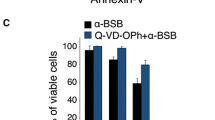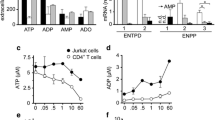Abstract
Tumor necrosis factor (TNF)-α, a pleiotropic cytokine, has been shown to induce diverse and opposite effects on lymphoid malignancy depending on TNF receptor system expression. Based on this, we investigated its in vitro dose- and time-related effect on the malignant B-cell line Raji, derived from Burkitt lymphoma patients, at different intracellular levels. The membrane alteration was estimated by lactate dehydrogenase (LDH) release and by flow cytometry; intracellular metabolic energy by determination of the total intracellular LDH activity; total cytosole protein mass by sulforhodamine B assay; and cell growth by incorporation of [3H]thymidine into DNA. Significant increase of LDH through cell membrane alteration was accompanied by decrease of intracellular metabolized energy and total protein mass. TNF-α at lower concentrations (125 and 250 pg/ml) significantly induced cell proliferation in comparison with 1,000 pg/ml of TNF-α, which induced more cell death. TNF-α induced maximal apoptosis rate up to 30% after 24 h, showing more effects for a necrotic form of cell death. Here we reported opposite and diverse effects of TNF-α at different intracellular levels in Raji cells, when applied in different assays, showing characteristics for every cellular compartment.







Similar content being viewed by others
References
Zheng C, Fischer G, Miller RE, Peschon J, Lynch DH, Lenardo MJ (1995) Induction of apoptosis in mature T cells by tumor necrosis factor. Nature 377:348–352
Ross ME, Caligiuri MA (1997) Cytokine-induced apoptosis of human natural killer cells identifies a novel mechanism to regulate the innate immune response. Blood 89:910–918
Vajant H, Scheurich P (2001) Tumor necrosis factor receptor-associated factor (TRAF2) and its role in TNF signaling. Int J Biochem Cell Biol 33:19–32
Trubiani O, Ciancarelli M, Rapino M, Di-Primo R (1995) Cytokines and programmed cell death in Burkitt lymphoma cells. Biochem Mol Biol Int 37:17–24
Jurisic V, Bogdanovic G, Srdic T, Jakimov D, Mrdjanovic J, Baltic M, Baltic VV (2004) Modulation of TNF-α activity in tumor PC cells using anti-CD45 and anti-CD95 monoclonal antibodies. Cancer Lett 214:55–61
Pasparakis M, Alexopoulou L, Episkopou V, Kolllias G (1996) Immune and inflammatory response in TNF-α formation of primary B cell follicles, follicular dendritic networks and germinal centers, and in the maturation of the humoral immune response. J Exp Med 184:1397–1411
Smith CA, Farrah T, Goodwin RG (1994) The TNF receptor superfamily of cellular and viral proteins: activation, costimulation and death. Cell 75:959–962
Haranaka K, Satomi N (1991) Cytotoxic activity of tumor necrosis factor (TNF) on human cancer cells in vitro. Jpn J Exp Med 51:191–194
Yahagisawa K, Watanabe I, Inoue Y, Horiuchi T, Hasegawa H, Yasukawa M, Fujita S (1996) Diverse effects of tumor necrosis factor-alpha on three subclones from human myelomonocytic leukemia cell lime ME-1 exhibiting different differentiation stage. J Interferon Cytokine Res 16:685–693
Williams MA, Newland AC, Kelsey M (2000) Cytokine modulated cell-membrane bound tumor necrosis factor expression is a associated with enhanced monocyte-mediated killing of human leukemic targets. Leuk Res 24:317–330
Gruss HJ (1996) Molecular, structural and biological characteristics of the tumor necrosis factor ligand superfamily. Int J Clin Lab Res 26:143–159
Walczak H, Miller RE, Ariail K, Gliniak B, Griffith TS, Kubin M, Chin W, Jones J, Woodward A, Le T, Smith C, Schuh JC, Lynch D (1999) Tumoricidal activity of tumor necrosis factor-related apoptosis-inducing ligand in vivo. Nat Med 5:157–163
Boise LH, Gonzals Garcia M, Postema CE, Ding L, Lindstein T, Turka LA, Mao X, Nunez G, Tompson CB (1993) bcl-x, and bcl-2-related gene that functions as a dominant regulator of apoptosis cell death. Cell 74:597–608
Schmitt E, Steyaert A, Cimoli G, Bertrand R (1998) Bax-α promotes apoptosis induced by cancer chemotherapy and accelerates the activation of caspase 3-like cysteine proteases in p53 double mutant B lymphoma Namalwa cells. Cell Death Differ 5:506–516
Reed JC (1995) Bcl-2 family proteins-regulators of chemoresistance in cancer. Toxicol Lett 3:155–158
Reed JC (1997) Double identity for proteins of the Bcl-2 family. Nature 387:773–776
Pollock PV, Lofthouse EJ, Jupp JO, Stephen BC, Gauld BS, Anderson MH, MacEwan JD (2000) Selective down-regulation of the Gqa/G11a G protein family in tumor necrosis factor-α induced cell death. Mol Cell Biochem 206:67–74
Hengartner MO (2000) The biochemistry of apoptosis. Nature 407:770–776
Faraco PR, Ledgerwood EC, Vandenabeele P, Prins JB, Bradley JR (1999) Tumor necrosis factor induces distinct patterns of caspase activation in WEHI-164 cells associated with apoptosis or necrosis depending on cell cycle stage. Biochem Biophys Res Commun 261:385–392
Sachs L, Lotem J (1993) Control of programmed cell death in normal and leukemic cells: new implication for therapy. Blood 82:25–21
Wyllie AH (1995) Apoptosis: cell death in tissue regulation. J Pathol 153:313–316
Thompson CB (1995) Apoptosis in the pathogenesis and treatment of disease. Science 267:456–1462
Rauthe G, Sistermanns J (1997) Recombinant tumor necrosis factor in the local therapy of malignant pleural effusion. Eur J Cancer 33:226–231
Hieber U, Heim ME (1994) Tumor necrosis factor for the treatment of malignancies. Oncology 51:142–145
Nicholson DW (2000) From bench to clinic with apoptosis-based therapeutic agents. Nature 407:810–816
Jurisic V, Bumbasirevic V, Konjevic G, Djuricic B, Spuzic I (2004) TNF-α induced changes in LDH isotype profile following triggering of apoptosis in PBMC of non-Hodgkin’s lymphoma. Ann Hematol 83:84–91
Lans TE, Bartlett DL, Libutti SK, Gnant MF, Liewehr DJ, Venzon DJ, Turner EM, Alexander HR (2001) Role of tumor necrosis factor on toxicity and cytokine production after isolated hepatic perfusion. Clin Cancer Res 7:784–790
Arnott HC, Scott KA, Moore RJ, Hewer A, Philips HD, Parker P, Balkwill FR, Owens DM (2002) Tumor necrosis factor-alpha mediates tumor promotion via a PKCα- and AP-1-dependent pathway. Oncogene 21:4728–4738
Konjevic G, Jurisic V, Spuzic I (1997) Correction to the original lactate dehydrogenase (LDH) release assay for the evaluation of NK cell cytotoxicity. J Immunol Methods 200:199–201
Jurisic V, Spuzic I, Konjevic G (1999) A comparison of NK cell cytotoxicity with effects of TNF-alfa against K-562 cells, determined by LDH release assay. Cancer Lett 138:67–72
Jurisic V (2003) Estimation of cell membrane alteration after drug treatment by LDH release. Blood 101:2894
Jurisic V, Konjevic G, Banicevic B, Djuricicic B, Spuzic I (2000) Different alteration in lactate dehydrogenase activity and profile of peripheral blood mononuclear cells in Hodgkins and non-Hodgkin’s lymphomas. Eur J Haematol 64:259–266
Kubota T, Takahara T, Nagata M, Furukawa T, Kase S, Tanino H, Ishibiki K, Kitajima M (1993) Colorimetric chemosensitivity testing using sulphorhodamine B. J Surg Oncol 52:83–88
Yoshida N, Ishii E, Mohri S, Nagumo F, Yoshidomi S, Miyazaki S (1999) Suppression of growth and dissemination in human pre-B leukemia cells by tumor necrosis factor-α in Scid mice. Leuk Lymphoma 33:107–118
Di-Pietro R, Rana R, Vitale M, Centurione MA, Stuppia L, Centurione L, Santavenere E (1997) TNF-alpha-induced apoptosis in Daudi cells: multiparametric analysis. Cytokine 9:463–470
Wissing D, Mouritzen H, Egeblad M, Poirier GG, Jaattela M (1997) Involvement of caspase-dependent activation of cytosolic phospholipase A2 in tumor necrosis factor-induced apoptosis. Proc Natl Acad Sci U S A 94:5073–5077
Lobner D (2000) Comparison of the LDH and MTT assays for quantifying cell death: validity for neuronal apoptosis? J Neurosci Methods 15:147–152
Wilkins RC, Kutzner BC, Truong M, Sanchez-Dardon J, McLean RN (2002) Analysis of radiation-induced apoptosis in human lymphocytes: flow cytometry using Annexin V and propidium iodide versus the neutral comet assay. Cytometry 48:14–19
Leist M, Ganter F, Kunstle G, Bohlinger I, Tiegs G, Bluethmann H, Wendel A (1996) The 55-KD tumor necrosis factor receptor and CD95 independently signal murine hepatocyte apoptosis and subsequent liver failure. Mol Med 2:109–124
Chen W, Wang HG, Srinivasula SM, Alnemri ES, Cooper NR (1999) B-cell apoptosis triggered by antigen receptor ligation proceeds via a novel caspase-dependent pathway. J Immunol 163:2489–2491
Grell M, Zimmermann G, Gottfried E, Chen CM, Grunwald U, Huang DC, Wu-Lee YH, Durkop H, Engelmann H, Scheuich P, Wajant H (1999) Induction of the cell death by tumor necrosis factor (TNF) receptor 2, CD40 and CD30: a role for TNF-R1 activation by endogenous membrane-anchored TNF. EMBO J 18:3034–3039
Voelkel-Jonson C, Entingh AJ, Wold SMW (1995) Activation of intracellular proteases is an early event in TNF-induced apoptosis. Immunology 154:1707–1716
Okazaki T, Kondo T, Kitano T, Tashima M (1998) Diversity and complexity of ceramide signalling in apoptosis. Cell Signal 10:685–692
Porter GA (1999) Protein translocation in apoptosis. Trends Cell Biol 9:394–401
Haggins CF (1999) Membrane permeability transporters and channels: from disease to structure and back. Curr Opin Cell Biol 11:495–499
Johrer K, Janke K, Krugmann J, Fiegle M, Greil R (2004) Transendothelial migration of myeloma cells is increased by tumor necrosis factor (TNF-alpha) via TNF receptor 2 and autocrine up regulation of MCP-1. Clin Cancer Res 10:1901–1910
Pan LX, Xu JN, Isaacsons PG (1991) Cellular H and M type lactate dehydrogenase (LDH) isoenzymes and tumor diagnostics: an immunohistochemical assessment. J Pathol 163:53–60
Marjanovic S, Skog S, Heiden T, Tribukait B, Nelson BD (1991) Expression of glycolitic enzymes in activated human peripheral lymphocytes: cell cycle analysis using flow cytometry. Exp Cell Res 193:425–431
Wolberg P, Nelson BD (1992) Regulation of the expression lactate dehydrogenase isoenzymes in human lymphocytes. Mol Cell Biochem 110:161–164
Weidmann E, Brieger J, Jahn B, Hoelzer D, Bergmann L, Mitrou PS (1995) Lactate dehydrogenase-release assay: a reliable, non-radioactive technique for analysis of cytotoxic lymphocyte-mediated lytic activity against blast from acute myelocytic leukemia. Ann Hematol 70:153–158
Jurisic V, Kraguljac N, Konjevic G, Spuzic I (2005) TNF-α induced changes in cell membrane antigen expression on K-562 cells associated with increased lactate dehydrogenase (LDH) release. Neoplasma 52:25–31
Nehar D, Mauduit C, Boussouar F, Benahmed M (1997) Tumor necrosis factor alpha stimulated lactate production is linked to lactate dehydrogenase A expression and activity increase in porcine cultured Sertoli cells. Endocrinology 138:1964–1971
Fujishiro Y, Kishi H, Matsuda T, Fuse H, Murguci A (2000) Lactate dehydrogenase A-dependent surface expression of immature thymocyte antigen-1: an implication for novel trafficking function of lactate dehydrogenase-A during T cell development. Eur J Immunol 30:516–524
Jurisic V, Colovic M (2002) Correlation of sera TNF-α with percentage of bone marrow plasma cells, LDH, β-2 microglobulin and clinical stage in multiple myeloma. Med Oncol 19:133–139
Aubry JP, Blaecke A, Leoanet-Henchoz S, Jeanin P, Herbault N, Caron G, Moine V, Bonnefoy JY (1999) Annexin V used for measuring apoptosis in the early events of cellular cytotoxicity. Cytometry 37:197–204
Prieto A, Diaz D, Barcenilla H, Garcia-Suarez J, Reyes E, Monserrat J, Antonio ES, Melero D, de la Hera A, Orfao A, Alvarez-Mon M (2000) Apoptotic rate: a new indicator for the quantification of the incidence of apoptosis in cell cultures. Cytometry 48:185–193
Kumamura S, Ishikura H, Tsumura H, Iwata Y, Endo J, Kobayashi S (1996) c-Myc and Bcl-2 protein expression during the induction of apoptosis and differentiation in TNF-α treated HL-60 cells. Leuk Lymphoma 23:383–394
Kuroki J, Hirokava A, Kitabayashi M (1996) Cell-permeable ceramide inhibits the growth of B lymphoma Raji cells lacking TNF-α receptors by inducing G0/G1 arrest but not apoptosis: a new mode for dissecting cell-cycle arrest and apoptosis. Leukemia 10:1950–1958
Genestier M, Revillard JP, Flacher M, Rouault JP, Bonnefoy-Berard N (1995) Tumor necrosis factor-alpha up-regulates Bcl-2 expression and decreases calcium-dependent apoptosis in human B cell lines. Int Immunol 7:533–540
Vander-Haiden MG, Thompson CB (1999) Bcl-2 proteins: regulators of apoptosis or of mitochondrial homeostasis? Nat Cell Biol 1:209–216
Acknowledgements
This work was partly supported by a grant from the Serbian Ministry of Science, Technology and Development. We thank Dr. Haral Wajant, Germany, for the TNF-α.
Author information
Authors and Affiliations
Corresponding author
Rights and permissions
About this article
Cite this article
Jurisic, V., Bogdanovic, G., Kojic, V. et al. Effect of TNF-α on Raji cells at different cellular levels estimated by various methods. Ann Hematol 85, 86–94 (2006). https://doi.org/10.1007/s00277-005-0010-3
Received:
Accepted:
Published:
Issue Date:
DOI: https://doi.org/10.1007/s00277-005-0010-3




